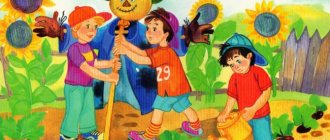Why is the ladybug called that?
Why is a cute little red bug with little black dots on its wings called a “bug”? Where have you seen flying cows, and red ones at that?
It turns out that everything is not without reason. The cow gives milk, and so does the cow. At the slightest danger, droplets of orange liquid appear on the bends of the legs of this insect. But the “milk” tastes bad and smells bad.
Why is the ladybug called "ladybug"? The bug gives the impression of a kind and touching creature - apparently this is the reason.
Children love ladybugs. They are bright, friendly (they can crawl along your hand for a long time). BUT! In fact, this young lady in a bright dress is not so harmless.
Sandwiches “Ladybugs”
You will need:
Sliced loaf Red fish (salmon, trout, pink salmon, salmon) Butter Tomatoes Pitted olives Parsley
Preparation:
1. Separate red fish from bones and skin, cut into thin slices. 2. Take a loaf, cut each sliced loaf in half. 3. Brush each half of the slice with butter. 4. Place a piece of red fish on top. 5. Take tomatoes and cut them in half. Cut each half halfway until you get ladybug wings. 6. Make the head of a ladybug using an olive cut in half. 7. Make spots for the ladybug using finely chopped pieces of olives.
8. Place the ladybugs on the red fish and garnish with a sprig of parsley! Tasty and beautiful!
What can you tell children about ladybugs?
- The number of spots has nothing to do with the age of the ladybugs.
- Not all ladybugs are red, there are many other species.
- The liquid that the insect secretes and the bright color scare away enemies, warning that the hostess is “inedible”. If a lizard or bird does not take your word for it, it will receive proof of its mistake immediately!
- Ladybug is a predator. Beware, aphids! Shoo, spider mite! There is no point in sucking the juices out of young plants! Red cows have a lot of work to do, but there is always plenty of food. So it’s not for nothing that gardeners love the ladybug so much.
www.animalsglobe.ru
- As soon as the first greenery appears in the fields, the ladybug begins to work tirelessly. One ladybug destroys up to 200 insects per day. The larvae have an even better appetite.
- Of course, you can’t kill a ladybug. You can read her a poem and let her go. According to ancient beliefs, the cow lives in the sky and only sometimes comes down to earth. You can find out from her what the weather will be like and whether the harvest will be successful.
- In Germany it is called the St. Mary's beetle, in England - the Lady Bird. In fact, she is COCCINELLIDA. But she won’t pronounce this name herself. Let’s just call it “cow”, it’s more common.
After such an educational program, your baby will definitely not offend the ladybug and, most likely, will think about the benefits of other spider bugs that he meets on a walk.
About the ladybug for children, methodological development on the world around us (preparatory group)
About ladybug for children
With the arrival of spring and summer, many different insects appear in nature. Children love to watch beautiful butterflies and beetles. When taking a walk in nature with children, you can definitely come across beautiful bugs with black dots. Among the huge variety of large and small beetles that busily scurry around gardens, fields and vegetable gardens, ladybugs are popular among people. Let's look at these bugs and tell the children about the ladybug.
Why are bugs called ladybugs, why are they bugs, if they are beetles, why do they have such a color, what benefits do they bring and how do they develop.
A story for children about a ladybug
These little bugs have a very attractive bright appearance. Their coloring is memorable at first sight. These insects have long earned human interest.
In many countries, various legends and superstitions are associated with them; people came up with proverbs and fairy tales about them.
We call them “ladybugs”. In some countries of Eastern Europe, these bugs are affectionately called “sun”, and in Western Europe - “Virgin Mary’s bug”.
Where do the bugs live? Everywhere except Antarctica. They are also found here, in the countries of Northern, Western and Eastern Europe, India, Great Britain, Italy and France.
Why are bugs called ladybugs? God's means meek, safe. Why a cow if it's a beetle? When it sits calmly in a person's palm, it is safe. And as soon as you press it a little, the insect secretes a yellow “milk” liquid. That's why they called her ladybug.
In general, beetles are predators. Ladybugs or coccenilides (as the family of beetles is called in Latin), like their larvae, feed mainly on aphids. For this they are also called aphid cows. In addition to aphids, ladybugs and their larvae destroy scale insects, spider mites, small caterpillars, and egg-laying insects, i.e. the most dangerous agricultural pests.
The bugs are very active, run quickly through plants and can fly long distances.
Bugs have a very enviable appetite. Each person needs fifty aphids a day.
Ladybug larvae also do not complain of lack of appetite: about a thousand aphids are required for their development. The larvae grow very quickly. Several generations can develop in a year.
Appearance of a ladybug
Insects look very bright. Their round backs are red, orange or yellow and covered with dotted spots. There can be a different number of points. There are individuals with two points, with 12, 30. The most common is the seven-spot ladybird.
By the way, the 28-spotted individual is a vegetarian and a pest: it eats potatoes, beets and clover.
Bright signs make ladybugs easily recognizable even by small children.
Entomologists also consider those with commas and dashes on their backs to be ladybugs, while others have a bizarre pattern. There are beetles even in a black outfit, and not just in a red or yellow suit. And they also have pea dots. There are more than 4,000 different species of ladybugs.
Varieties of ladybugs
Ladybugs have a head, pronotum, thorax, abdomen, 3 pairs of legs, hard elytra and transparent wings, with the help of which the insect flies. Large eyes and movable antennae.
The bug flies with the help of two hind wings, and the hard elytra serve as protection.
During flight, the insect makes up to 85 strokes per second. And it will be interesting for children to see that under the hard elytra there are transparent wings with which the insect flies.
Why does an insect need such a bright outfit? To protect yourself from enemies! This is a warning coloring: “I am not edible!” it says.
If you pick up a bug and inadvertently press it, it will release an orange drop. It contains the poison cantharidin. it is not dangerous for people, but if a bird grabs a ladybug, it will burn its throat so much that it will no longer want to touch it. This is how the little insect feels safe.
How does a ladybug develop?
In the spring, insects begin to have trouble breeding offspring. They are looking for a mate. The female lays up to 400 yellow eggs on the leaves of plants.
The female, taking care of her offspring, chooses plants that grow near the habitats of aphids. After 1-2 weeks, larvae emerge from the eggs. They first feed on the egg shell, as well as unfertilized eggs. Then they get to the aphids. The larval stage lasts 4-7 weeks. When the larvae accumulate nutrients, they turn into pupae. The pupa is attached to the leaf. After 7-10 days, an adult insect crawls out of the pupa shell. He doesn't have any spots yet. The bug sits and waits. Then the corresponding color and spots appear.
Adult beetles usually overwinter. They are thermophilic. If the climate is cold, ladybugs gather in flocks and fly to warmer climes. If they remain, they gather in colonies and hide under stones and tree bark and thus wait out the winter cold.
Wintering ladybugs
The benefits and harms of ladybugs
The gluttony of ladybugs brings great benefits to gardens and vegetable gardens in many countries. If one larva eats 50 aphids per day, then an adult insect eats up to 100 individuals.
The beetles are specially bred and then sprayed over gardens using aircraft.
But there are also harmful individuals that eat vegetables.
Interesting facts about the ladybug
Since ancient times, ladybugs have even been worshiped. The Slavs considered her a messenger of the Sun Goddess.
It was used to predict the weather. If the bug flies away from the palm on which it was sitting, then the weather will be good. And if he doesn’t want to fly, there will be bad weather.
Since ancient times in Western countries, people have considered the ladybug a symbol of good luck. The image of a bug on clothes was like a talisman.
There are many signs associated with this bug. If a ladybug flies towards you, do not rush to drive it away so as not to frighten away your fortune. Having flown into the house, it promises peace and harmony, and for childless families, the appearance of a child.
Cookie Policy
about the author
A teacher, philologist, she was engaged in local history work at a school in the village of Magnitka, Chelyabinsk region.
Author of several projects on the history of the Urals. One of the projects is dedicated to the post-war history of the village where the German prisoner of war camp was located.
Lyubov Alyamkina’s stories were published in various magazines and newspapers: “Ural Pathfinder” (Ekaterinburg), “Arguments of the Week” (Chelyabinsk), “District Life” (Kusa), “Russian Germany” (Berlin), “Russian Germans” (Moscow) and etc.
LADYBUG
There was one bug living in the forest. It was so small that it could fit on your little finger. There were tiny black peas on its bright orange wings.
This bug's name was Ladybug.
One day, Ladybug was basking in the sun on a white chamomile petal. How many of them grew here in the clearing!
Ladybug lived very happily and thought that there was nothing better in the world than her forest.
And suddenly children ran into the clearing with noise and cheerful screams.
“Oh, look, Ladybug,” one boy shouted joyfully and carefully took her off the flower, “how pretty she is!”
Ladybug fearlessly walked along the boy's hand, and the children jumped around and sang:
Ladybug,
Fly to the sky
Your kids are there
They eat sweets.
Ladybug thought that this was true and, spreading her wings, flew up. But she didn’t find any of her children there, and no one treated her to candy in heaven. Sad, she sat down on a bush and cried. She so wanted to see her children and eat at least one piece of candy.
At this time, two swallows were sitting on a branch nearby. They hid among the leaves of a tree from a suddenly blowing cold wind.
“Autumn is coming,” said one of them, “and we will fly to warm countries again.”
Ladybug thought:
- What if we fly away with them?
“Take me with you!” she asked the birds.
“We don’t feel sorry, we don’t feel sorry,” they sang.
And when autumn came, the birds rose high, high into the sky, flying to warm lands, not forgetting about the Ladybug, who was so warm and cozy among the feathers of one of the birds. Forests, steppes, mountains, and rivers rushed by below. Ladybug was so tired from the journey that she fell asleep unnoticed.
“Get up, we’ve already arrived,” the swallow woke her up.
It was so wonderful all around! Palm trees, strange plants, bright flowers - Ladybug has never seen such divine beauty. Birds in bright plumage walked among the fragrant bushes.
“I’ll stay here forever!” thought Ladybug.
She sat on an olive branch and thanked the swallow.
“Goodbye!” said the bird. “When we return home, we will fly to you.”
Ladybug didn't answer.
She didn’t even notice how close the Peacock came in his festive attire. He squinted one eye and began to peck at the berries.
Suddenly, Ladybug felt a terrible blow, from which she fell to the ground and miraculously remained alive. It was the Peacock who hit her with his beak. Everything happened so quickly that poor Ladybug barely recovered from her fear and spent the whole day sitting on the ground under a fallen leaf.
Now she had to be careful and hide at times.
Nobody knew her in this country. The grasshoppers did not greet her in the morning, the caterpillar did not crawl past her, having managed to tell the forest news, butterflies with fabulously beautiful wings simply did not want to notice her, flying past indifferently.
And most importantly, no one sang a song to her and was not happy when they met.
Life has become so sad and lonely!
And when the familiar swallows appeared in the sky again, returning to their homeland, where spring had come again, Ladybug’s heart was ready to jump out of her chest with joy.
“I want to go home so bad!” she shouted.
“I know,” answered the swallow, “I thought so.”
So Ladybug found herself back in her native forest.
Now she was not offended by the children’s song, she was happy and laughed with them.
WALK
The little badger lived with his mother in his hole. She warned him all the time:
-Baby, don’t go out alone, because you haven’t grown up yet. You may be in danger.
But one day, when mom was not at home, the little badger got bored at home alone, and he decided to go outside.
The sun was shining so gently, the breeze was blowing so gently that the baby immediately forgot about caution and ran along the forest path
And suddenly he felt that someone had bitten him painfully on the nose. It turned out to be a large mosquito, which was in no hurry to fly away.
“So that’s what you are, Danger!” exclaimed the little badger.
The mosquito laughed:
“My bite will make your nose hurt a little, that’s all, but the Danger is completely different.”
“What does she look like?” asked the baby.
“It’s green, big and croaks so disgustingly!” explained the mosquito. And he flew away.
The little badger walked further. His feet were buried in the greenery of soft moss, the flowers nodded their heads, welcoming him. Suddenly a frog jumped onto a rotten stump.
“Kwa, kwa,” she greeted the baby, looking at his striped back with curiosity.
The little badger's heart sank with fear. But the frog smiled welcomingly at him and asked him to play with her.
“Let's jump rope?” she suggested.
“Come on,” the little badger answered joyfully.
Having played enough, he asked her:
- Tell me about Danger.
“She has wings and a sharp beak,” croaked the frog and immediately hid in the thick grass.
Before the little badger had time to take even a few steps, a magpie sat down on the path. The little badger huddled to the ground. But the magpie, looking at him friendly, handed him red berries in her beak, so large and ripe that the baby could not refuse such a treat.
“Eat, they’re so tasty,” the magpie chattered, “I know a clearing where there are a lot of them.”
“So you’re not Danger?” asked the kid, gobbling up berries on both cheeks.
“Where is the Danger, where?” the magpie chattered again, looking around.
-What is she like?
“So you haven’t seen her yet?” the new acquaintance was surprised. “She’s red, with a bushy tail.”
And the magpie quickly flew away.
The kid also decided to hurry home. At that moment a squirrel appeared next to him.
“Oh!” cried the little badger.
Now he was convinced that he had encountered real danger.
“Why are you scared?” the squirrel was surprised. “Do you want me to treat you to some nuts?”
“I’m afraid of you because you’re red and have a tail,” the little badger explained to her.
“But I’m not a fox,” she explained, guessing who she was mistaken for, and instantly jumped onto a tree and threw him nuts from there.
The little badger was so hungry after a long walk that he ate the delicious nuts with gusto.
And when he came home, his mother was already waiting for him and was terribly worried.
The little badger told her about his adventures.
“The danger is different for everyone, everyone has their own,” his mother explained to him and affectionately stroked his head.








